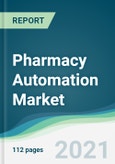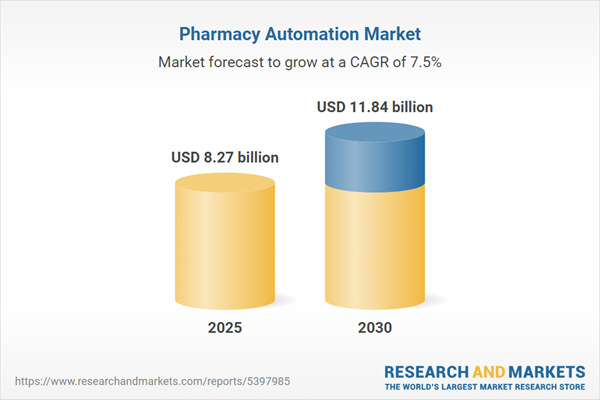Pharmacy Automation Market Size:
The Pharmacy Automation Market is expected to grow from USD 8.265 billion in 2025 to USD 11.843 billion in 2030, at a CAGR of 7.46%.The pharmacy automation market is experiencing robust growth, driven by rising healthcare costs, stringent regulatory standards, and the global surge in e-prescriptions. Pharmacy automation devices, including packaging and labeling systems, medication dispensing, compounding, and storage and retrieval systems, enhance efficiency and reduce medication errors, allowing pharmacists and clinicians to focus on patient care. Technological advancements in precise automation tools and untapped opportunities in emerging economies like Brazil, China, and India are key growth catalysts, positioning the market for significant expansion.
Market Drivers
Dominance of Hospital and Retail Pharmacies
Hospital and retail pharmacies are the primary end-users of pharmacy automation, fueled by a growing aging population and increasing road accidents, which drive patient volumes. The rising demand for over-the-counter (OTC) drugs and the growing number of prescriptions handled by local pharmacists globally are expanding the retail pharmacy segment. According to the World Health Organization, road traffic crashes result in approximately 1.35 million deaths annually and cost most countries 3% of their GDP, underscoring the need for efficient pharmacy operations to manage increased prescription demands.Increased Investments and Collaborations
The ongoing impact of the COVID-19 pandemic has heightened the need for solutions that enhance visibility, reduce costs, and manage complex pharmacy supply chains. This has led to increased investments, product launches, and collaborations in the pharmacy automation market. These initiatives aim to address operational challenges and improve patient safety, creating significant growth opportunities as companies innovate to meet evolving healthcare demands.Market Trends
Technological advancements are driving the development of precise automation tools, such as robotic packaging systems and RFID-based solutions, which enhance productivity and patient safety. Strategic collaborations and acquisitions are also shaping the market. For instance, the focus on software-enabled automation and integration with existing pharmacy platforms is evident in new product introductions, such as advanced blister cards and medication compliance packaging designed for major automation platforms. These innovations streamline operations and improve medication adherence.Market Restraints
While not explicitly detailed, potential challenges include high initial costs for automation systems, integration complexities with existing healthcare infrastructure, and the need for trained personnel to operate advanced technologies. These factors could limit adoption, particularly in resource-constrained settings, requiring strategic solutions to ensure scalability.Geographical Outlook
North America holds the largest market share for pharmacy automation, driven by high rates of prescription errors, with the FDA reporting at least one daily death and 1.3 million annual injuries in the U.S. due to medication errors. Europe follows as a significant market, supported by advanced healthcare systems. The Asia-Pacific (APAC) region is expected to experience the fastest growth, driven by the increasing adoption of electronic health records (EHRs), e-prescribing, and computerized physician order entry (CPOE) in healthcare facilities. The region’s growing medical tourism industry further amplifies demand for automation in hospitals and retail pharmacy chains to enhance productivity.The pharmacy automation market is poised for substantial growth, propelled by rising healthcare costs, regulatory pressures, and the global rise in e-prescriptions. Hospital and retail pharmacies dominate due to increasing patient volumes, while technological advancements and strategic collaborations drive innovation. The APAC region’s rapid adoption of digital health solutions and medical tourism growth presents significant opportunities, with North America leading in market share. Industry stakeholders should focus on overcoming cost and integration barriers while leveraging advancements in automation to enhance efficiency and patient safety in the evolving healthcare landscape.
Key Benefits of this Report:
- Insightful Analysis: Gain detailed market insights covering major as well as emerging geographical regions, focusing on customer segments, government policies and socio-economic factors, consumer preferences, industry verticals, and other sub-segments.
- Competitive Landscape: Understand the strategic maneuvers employed by key players globally to understand possible market penetration with the correct strategy.
- Market Drivers & Future Trends: Explore the dynamic factors and pivotal market trends and how they will shape future market developments.
- Actionable Recommendations: Utilize the insights to exercise strategic decisions to uncover new business streams and revenues in a dynamic environment.
- Caters to a Wide Audience: Beneficial and cost-effective for startups, research institutions, consultants, SMEs, and large enterprises.
What do businesses use these reports for?
Industry and Market Insights, Opportunity Assessment, Product Demand Forecasting, Market Entry Strategy, Geographical Expansion, Capital Investment Decisions, Regulatory Framework & Implications, New Product Development, Competitive IntelligenceReport Coverage:
- Historical data from 2022 to 2024 & forecast data from 2025 to 2030
- Growth Opportunities, Challenges, Supply Chain Outlook, Regulatory Framework, and Trend Analysis
- Competitive Positioning, Strategies, and Market Share Analysis
- Revenue Growth and Forecast Assessment of segments and regions including countries
- Company Profiling (Strategies, Products, Financial Information, and Key Developments among others.
Segmentation:
By Application
- Medical Dispensing System
- Packaging and Labeling System
- Robots Dispensing System
- IV Pharmacy
- Others
By End-user
- Hospital Pharmacy
- Pharmacy Chains
- Retail Pharmacy
By Geography
- North America
- USA
- Canada
- Mexico
- South America
- Brazil
- Argentina
- Others
- Europe
- UK
- Germany
- France
- Spain
- Others
- Middle East and Africa
- Saudi Arabia
- UAE
- Israel
- Others
- Asia Pacific
- Japan
- China
- India
- South Korea
- Taiwan
- Thailand
- Indonesia
- Others
Table of Contents
Companies Mentioned
- Omnicell
- Swisslog Healthcare (Talyst LLC)
- ScriptPro LLC
- ARxIUM
- Capsa Healthcare
- Parata Systems LLC
- McKesson Corporation
Table Information
| Report Attribute | Details |
|---|---|
| No. of Pages | 149 |
| Published | August 2025 |
| Forecast Period | 2025 - 2030 |
| Estimated Market Value ( USD | $ 8.27 billion |
| Forecasted Market Value ( USD | $ 11.84 billion |
| Compound Annual Growth Rate | 7.4% |
| Regions Covered | Global |
| No. of Companies Mentioned | 7 |









